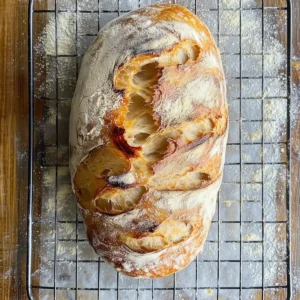Description
Batard bread is an easy loaf with a crisp crust and open crumb, filled with a warm, malty aroma.
Ingredients
Scale
- 500 g bread flour (unbleached, high-protein flour like King Arthur)
- 350 g water (room temperature)
- 10 g salt (fine sea salt)
- 2.5 g instant yeast
- 5 g diastatic malt powder
- 0.5 g ascorbic acid powder
- 100 g bread flour (for poolish)
- 100 g water (for poolish)
- 0.5 g instant yeast (for poolish)
Instructions
- In a bowl, mix 100 g bread flour, 100 g water, and 0.5 g instant yeast. Stir until the mixture is smooth and cover it. Let this rest at room temperature for 12 hours. The poolish should develop bubbles and a slightly domed surface, indicating it’s ready to use.
- In a large bowl, whisk together 400 g bread flour with 250 g water until no dry flour remains. Cover the bowl and allow it to rest for 30 minutes. This autolyse stage helps align gluten strands, making it easier to handle the dough.
- Sprinkle 10 g salt, 2 g instant yeast, 5 g diastatic malt powder, and 0.5 g ascorbic acid powder over the autolysed dough. Add the entire poolish mixture and mix by folding until everything is incorporated into a uniform dough.
- Every 30 minutes during bulk fermentation (set at 75°F), perform a series of four stretch-and-folds. Reach under one side of the dough, stretch it up, fold it over itself, and rotate the bowl 90°. Repeat this process for all four sides of the dough, allowing it to gain strength and develop air pockets without extensive kneading. Total bulk fermentation should last approximately 2 hours.
- Transfer the dough to a lightly oiled container, cover it, and place it in the refrigerator for 12 to 18 hours. This cold ferment deepens the flavor while providing flexibility in your baking schedule.
- Once cold ferment is complete, turn the dough onto a floured surface. Gently flatten it into a rectangle. Fold the top third down and the bottom third up, then rotate 90° and repeat. Let it rest seam side up for about 15 minutes.
- Dust your work surface with flour and gently flatten the dough into a 10×8-inch rectangle. Fold the sides in toward the center, sealing the seams with your fingertips, before turning it seam side down and rolling it into a 12-inch long batard. Place this loaf onto parchment paper and cover it with a proofing basket liner or towel. Proof at room temperature (between 70°F and 75°F) for 60 to 75 minutes, or until it passes the poke test (a gentle poke springs back slowly).
- Preheat your oven to 475°F with a baking stone or steel on the middle rack and a steam pan on the floor of the oven for at least 45 minutes. Once preheated, transfer the loaf (with parchment) onto the stone, score a long 6-inch slash down the center with a lame, then quickly pour 1 cup of hot water into the steam pan and close the oven door. Bake the bread for 15 minutes, then reduce the temperature to 440°F. After 15 more minutes, remove the steam pan, and bake until the crust is deep golden brown.
- Carefully remove the loaf using the parchment paper and place it on a cooling rack. Allow the bread to cool completely for about 2 hours before slicing.
Notes
- Incorporating a bubbly starter builds complexity and depth of flavor, which many recipes forgo.
- Essential for flavor enhancement and flexible baking schedules, this technique is often omitted in other recipes.
- Both ingredients boost yeast activity and improve browning; they should not be neglected, as this will affect the crust’s quality.
- Many recipes give vague instructions for steam; this precise method guarantees a consistent crust.
- Take care when scoring—angle and depth can significantly impact oven spring and final appearance.
- Cooled loaves should be stored in a paper bag at room temperature for up to 2 days. If you have leftovers, slice and freeze them in an airtight bag for up to a month.
- You can swap out up to 20% of the bread flour for whole wheat. Just increase the water by about 10 g if necessary.
Nutrition
- Serving Size: 1 slice
- Calories: 200
- Sugar: 0.5 g
- Sodium: 400 mg
- Fat: 1 g
- Saturated Fat: 0 g
- Unsaturated Fat: 0 g
- Trans Fat: 0 g
- Carbohydrates: 40 g
- Fiber: 2 g
- Protein: 6 g
- Cholesterol: 0 mg
